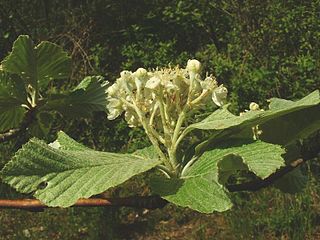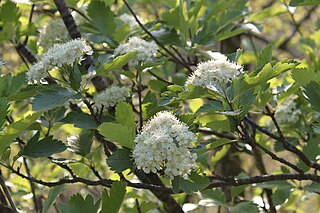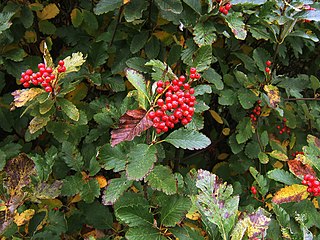
The rowans or mountain-ashes are shrubs or trees in the genus Sorbus of the rose family, Rosaceae. They are native throughout the cool temperate regions of the Northern Hemisphere, with the highest species diversity in the Himalaya, southern Tibet and parts of western China, where numerous apomictic microspecies occur. The name rowan was originally applied to the species Sorbus aucuparia and is also used for other species in Sorbus subgenus Sorbus.

Sorbus is a genus of over 100 species of trees and shrubs in the rose family, Rosaceae. Species of Sorbus (s.l.) are commonly known as whitebeam, rowan (mountain-ash) and service tree. The exact number of species is disputed depending on the circumscription of the genus, and also due to the number of apomictic microspecies, which some treat as distinct species, but others group in a smaller number of variable species. Recent treatments classify Sorbus in a narrower sense to include only the pinnate leaved species of subgenus Sorbus, raising several of the other subgenera to generic rank.

The whitebeams are members of the family Rosaceae, comprising subgenus Aria of genus Sorbus, and hybrids involving species of this subgenus and members of subgenera Sorbus, Torminaria and Chamaemespilus. They are deciduous trees with simple or lobed leaves, arranged alternately. They are related to the rowans, and many of the endemic restricted-range apomictic microspecies of whitebeam in Europe are thought to derive from hybrids between S. aria and the European rowan S. aucuparia; some are also thought to be hybrids with the wild service tree S. torminalis, notably the service tree of Fontainebleau Sorbus latifolia in French woodlands.

Sorbus torminalis, with common names wild service tree, chequers, and checker tree, is a species of tree in the mountain ash or rowan genus (Sorbus) of the rose family (Rosaceae), that is native to Europe, parts of northern Africa and western Asia.

Sorbus chamaemespilus, the false medlar or dwarf whitebeam, is a species of Sorbus native to the mountains of central and southern Europe, from the Pyrenees east through the Alps to the Carpathians and the Balkans, growing at altitudes of up to 2500 m.

Karpatiosorbus latifolia is a species of whitebeam that is endemic to the area around Fontainebleau, south of Paris in France, where it has been known since the early eighteenth century.

Sorbus cashmiriana, the Kashmir rowan, is a species of flowering plant in the family Rosaceae, native to the western Himalayas, including Kashmir.

Sorbus leyana. Ley's whitebeam is a species of small tree which is endemic to two sites in southern Wales. It is thought to have arisen by hybridisation of two species of Sorbus, one of which was the rowan. Its closest relatives are some of the other hybrid derived Sorbus species found in Britain.

Sorbus glabrescens is a species of rowan native to Yunnan in China.
Sorbus oligodonta, the kite-leaf rowan, is a species of rowan native to northern Yunnan, southeastern Tibet, and western Sichuan in China as well as to Myanmar.

Sorbus × hybrida, the oakleaf mountain ash, Swedish service-tree or Finnish whitebeam, is a hybrid species of whitebeam native to Norway, eastern Sweden, southwestern Finland, and locally in Latvia.

Alniaria alnifolia, also called alder-leafed whitebeam, Korean whitebeam, or Korean mountain ash, Korean: 팥배나무; RR: Patbaenamu; MR: p'atpaenamu; lit. 'red bean pear tree' Chinese: 水榆花楸; pinyin: shui yu hua qiu; lit. 'water elm rowan', is a species of whitebeam native to eastern Asia in eastern and northern China, Taiwan, Korea and Japan.

Sorbus mougeotii, the Vosges whitebeam or Mougeot's whitebeam, is a species of whitebeam native to the mountains of central and western Europe from the Pyrenees east through the Alps to Austria, and north to the Vosges Mountains.

Sorbus hupehensis is a species of rowan native to central and western China.

Sorbus sargentiana, Sargent's rowan is a species of flowering plant in the family Rosaceae, native to southwestern Sichuan and northern Yunnan in China, where it grows at altitudes of 2,000–3,200 m (6,560–10,500 ft).

Sorbus minima, commonly known as the lesser whitebeam or least whitebeam, is a shrub belonging to the subgenus Aria (whitebeams) in the genus Sorbus. It is endemic to Wales where it grows at a few sites in Breconshire. It is an apomictic microspecies which reproduces asexually and so is reproductively isolated from its close relatives such as the Swedish whitebeam, S. intermedia. It probably originated as a hybrid between the rock whitebeam and the rowan. It was first discovered in 1893 by Augustin Ley, the vicar of Sellack in Herefordshire who travelled widely in Wales.

Karpatiosorbus devoniensis is known by the English name of Devon whitebeam and formally as Broad-leaved Whitebeam. When the fruit was reported as sold at Barnstaple Pannier Market the name French Eagles was used, apart from 1929 when they were reported as eagle-berries. When the trees were reported as seen growing wild on botanical walks they were referred to as French Hails. Broad-leaved white-beam, which was the common name until Devon Whitebeam took over, was used once in 1907. The term Otmast was used once as a pet name, as its true identity was not known. It is a species of whitebeam, trees and shrubs in the family Rosaceae. It is endemic to the British Isles, growing wild in areas of Devon, Cornwall, Somerset and south-east Ireland as a native and north-east Ireland as an introduction.

Sorbus rupicola, known as rock whitebeam, is a rare shrub or small tree best known from the British Isles but also reported from Norway, Sweden and Russia.
Karpatiosorbus houstoniae, or Houston's whitebeam, is a hybrid of two deciduous trees: the common whitebeam and the Bristol whitebeam. Only a single example of the hybrid is known to exist, at the Avon Gorge in Bristol, England. The only specimen grows on a cliff below Stokeleigh Camp at Leigh Woods in North Somerset and cannot be accessed without ropes.




















